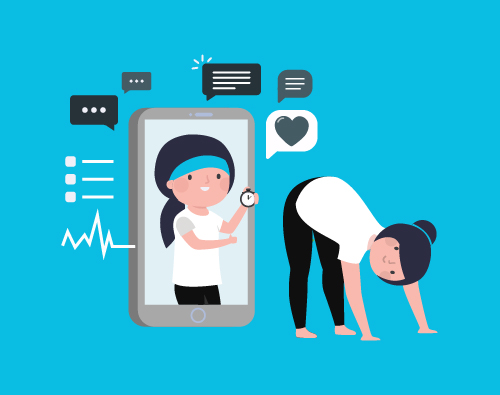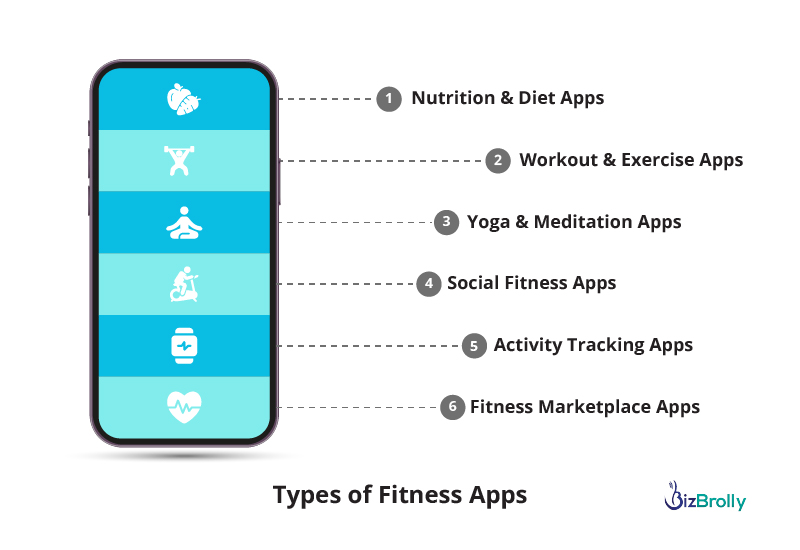Online Fitness Consultation Apps


Fitness is no longer limited to hitting the gym or attending traditional workout classes. Thanks to the rapid rise of mobile technology, fitness enthusiasts and health-conscious individuals now turn to fitness apps for personalized, convenient, and engaging solutions. These apps cater to a variety of wellness goals, including workout tracking, nutrition monitoring, and virtual connections with fitness professionals. According to a report by Statista, the global fitness app market was valued at approximately $6.7 billion in 2021 and is projected to reach $15.2 billion by 2028, growing at a CAGR of 12.9%.
This growing demand presents a lucrative opportunity for businesses eager to enter the fitness tech space. Fitness apps aren’t just about convenience—they offer users a more tailored and data-driven approach to health. Features like real-time progress tracking, AI-based personal training plans, and gamification have become standard to ensure user engagement and retention.
In this blog, we’ll explore the key elements of fitness app development, categorize the various types of fitness apps, and highlight essential considerations for compliance and user experience. Whether you’re a business planning to develop a fitness app or a tech enthusiast, understanding these essentials is critical to creating a successful app.
The global fitness app market is projected to grow exponentially, driven by increasing awareness of health and wellness. With users seeking convenience, personalization, and real-time tracking, fitness apps offer a unique opportunity to bridge the gap between technology and fitness. Businesses can create apps that not only cater to individual needs but also foster community engagement and long-term loyalty.
Key factors driving the popularity of fitness apps include:
Accessibility: Users can access workout plans, health data, and professional advice anytime, anywhere.
Personalization: Advanced algorithms provide customized recommendations based on user data and goals.
Engagement: Gamification, challenges, and social sharing features keep users motivated.

Understanding the various types of fitness apps is vital for businesses looking to stand out in the competitive fitness industry. These apps can be categorized into key segments, each catering to specific user needs. Some focus on workout plans and exercise tracking, offering personalized routines and progress monitoring. Others emphasize nutrition and diet, helping users manage calorie intake and meal planning. There are also apps dedicated to mental wellness, such as meditation and mindfulness tools, and those promoting social connectivity through fitness challenges and community support. Identifying these categories enables businesses to align with market demands and create unique offerings. Here are the primary categories:
Workout and exercise apps offer guided plans, video tutorials, and progress-tracking tools. Designed for all fitness levels, they provide personalized routines tailored to individual goals, helping users stay consistent and achieve desired results effectively.
Enable users to effortlessly track meals, monitor calories, and maintain a balanced diet. These apps offer personalized insights, helping individuals achieve and sustain their nutritional goals with ease and convenience.
Activity tracking apps integrate with wearable devices to monitor daily steps, heart rate, and overall activity levels. They deliver real-time insights into fitness progress and health metrics, empowering users to stay on top of their wellness goals and make informed decisions for a healthier lifestyle.
Yoga and meditation apps offer guided yoga sessions, calming meditation techniques, and stress-relief exercises to enhance mental and physical well-being. These apps cater to users seeking relaxation, focus, and a healthier lifestyle.
Fitness marketplace apps serve as platforms that connect users with personal trainers, gyms, and wellness professionals. They offer access to various services, from fitness classes to wellness consultations, all in one place.
Social fitness apps foster a sense of community by connecting fitness enthusiasts. They encourage engagement through challenges, leaderboards, and shared achievements. Users can track their progress, compete with friends, and stay motivated.
A successful fitness app integrates intuitive design, powerful features, and flawless performance. It ensures users can easily navigate, access personalized tools, and achieve their fitness goals without technical hiccups, creating an engaging and reliable experience that keeps them motivated and coming back for more. Essential features include:
User Profiles: Let users create personalized profiles to set fitness goals and monitor their progress. Enhance engagement by tailoring recommendations to individual preferences.
Workout and Meal Plans: Offer customizable workout routines and nutrition plans to suit diverse fitness levels and goals. Provide flexibility for users to adapt plans to their schedules.
Integration with Wearables: Sync seamlessly with wearables like smartwatches to provide real-time tracking of activity and health metrics. Enhance user experience with automatic data updates.
Push Notifications: Keep users engaged with timely reminders, motivational messages, and updates about their progress. Encourage consistency with gentle nudges and goal milestones.
Social Sharing: Build community spirit by allowing users to share achievements and connect with like-minded individuals. Foster competition and camaraderie through leaderboards and challenges.
Progress Tracking: Provide detailed analytics on workouts, calories burned, and goals achieved. Use visual graphs and reports to showcase improvements and inspire motivation.
Gamification: Boost motivation by adding badges, rewards, and challenges to the app experience. Turn fitness into a fun and engaging activity with a sense of accomplishment.
Fitness app development requires the integration of advanced technologies to ensure a smooth and engaging user experience. By leveraging features like real-time data syncing, personalized plans, and intuitive design, these apps offer users a seamless platform for tracking fitness goals, managing workouts, and staying motivated throughout their journey. Some key technologies include:
AI and Machine Learning: AI and machine learning analyze user data to create customized workout plans and offer intelligent recommendations. These technologies adapt to user progress, providing more accurate and effective fitness guidance.
IoT and Wearables: Integrating IoT and wearables allows fitness apps to sync with devices like smartwatches for real-time tracking. Users benefit from automatic updates and detailed performance insights during workouts.
Cloud Computing: Cloud computing ensures secure storage and easy access to user data across devices. It enables seamless syncing, allowing users to access their progress and plans anytime, anywhere.
AR and VR: AR and VR technologies create immersive workout environments, enhancing engagement. These technologies offer virtual challenges and realistic simulations, making workouts more interactive and fun.
Blockchain: Blockchain secures sensitive user data and transactions by providing decentralized, transparent records. This ensures privacy and trust, particularly for apps handling payments or personal health information.
Building a fitness app involves handling sensitive user data, making compliance with relevant regulations essential. Here are some critical considerations:
To make your fitness app a profitable venture, consider these monetization models:
Offer basic features for free to attract a broad user base while providing the option to upgrade to a premium subscription. Premium plans can unlock advanced features like personalized coaching, detailed analytics, and exclusive workout content. This model works well for building a loyal customer base while generating steady revenue.
Provide access to exclusive content, personalized fitness plans, or virtual goods like workout accessories and avatars. Users can purchase additional features or services to enhance their fitness experience. This model keeps the app engaging and creates multiple revenue streams.
Collaborate with brands to display targeted ads within the app, such as fitness gear, supplements, or wellness programs. Ads can be strategically placed to minimize disruption while adding value to users through relevant recommendations. This approach can significantly boost revenue without charging users upfront.
Partner with fitness trainers, gyms, or wellness companies for cross-promotions and expanded offerings. Collaborations can include co-branded challenges, exclusive discounts for partner services, or sponsored content. These partnerships help enhance user trust and broaden your app’s reach.
Charge a one-time fee for downloading the app, offering a fully-featured experience from the start. This model works best for apps with unique features or high-value content that justifies the cost. It ensures upfront revenue while attracting users willing to invest in premium solutions.

Here’s a step-by-step guide to building a fitness app:
Market Research: Identify your target audience, analyze competitors, and define your unique value proposition. Dive deep into user pain points and preferences to ensure your app addresses unmet needs. Use surveys, interviews, and focus groups to validate your app idea and refine your approach.
Define Features: Prioritize essential features based on user needs and business goals. Include functionalities that deliver value quickly, such as personalized plans or social engagement tools. Create a roadmap for future enhancements to stay relevant as user demands evolve.
Design and Prototyping: Create intuitive and visually appealing UI/UX designs. Focus on usability and seamless navigation to ensure users stay engaged. Use wireframes and mockups to gather feedback early, iterating designs before moving to development.
Development: Choose the right technology stack and frameworks for app development. Opt for scalable solutions that can accommodate growth as your user base expands. Ensure the development process includes regular milestones to track progress and address potential roadblocks.
Testing: Conduct thorough testing to ensure functionality, security, and performance. Test across multiple devices and operating systems to identify compatibility issues. Use both manual and automated testing to catch bugs and optimize the user experience.
Launch and Marketing: Deploy the app on app stores and execute marketing campaigns to attract users. Leverage social media, influencer partnerships, and email campaigns to create buzz. Monitor early user feedback closely to make quick improvements post-launch.
Developing a fitness app comes with its set of challenges, including:
Data Privacy: Ensuring compliance with data protection regulations.
User Retention: Keeping users engaged and motivated to use the app consistently.
Integration with Wearables: Achieving seamless compatibility with multiple devices.
Scalability: Designing the app to handle a growing user base.
The fitness app industry continues to evolve with emerging trends, such as:
AI-driven coaching provides real-time feedback, adjusting workout plans based on user performance and progress. This ensures a tailored experience that evolves with the user’s fitness journey. By analyzing data from each session, AI can suggest improvements, helping users achieve their goals faster and more efficiently.
Virtual reality brings immersive fitness experiences directly into users’ homes, offering a wide variety of virtual classes and environments. Users can participate in dynamic workouts such as cycling, yoga, or boxing while feeling fully engaged in realistic, virtual settings. This technology turns exercise into an exciting and interactive adventure, motivating users to stay consistent.
Hybrid fitness models merge traditional in-person classes with virtual sessions, giving users flexibility to choose what works best for them. Whether they prefer the energy of a group class or the convenience of home workouts, this approach allows users to blend both worlds. It promotes inclusivity, enabling access to fitness regardless of location.
Fitness apps are increasingly incorporating sustainability features to encourage eco-friendly habits, such as promoting outdoor workouts or offering rewards for sustainable choices. Some apps integrate eco-friendly challenges, like biking instead of driving, while rewarding users with points or discounts. This encourages a healthy lifestyle that also benefits the planet, fostering a sense of responsibility.
At BizBrolly, we specialize in fitness app development, offering the expertise to help businesses succeed in the rapidly growing health and wellness market. We understand user needs, ensure compliance, and incorporate cutting-edge technologies to build fitness apps that stand out. Whether you’re aiming to help users reach their fitness goals or foster a vibrant community, we have the skills to make it happen.
With our guidance, we ensure a smooth development journey from concept to launch, creating an app that drives engagement and success. Let us bring your fitness app idea to life and turn it into a competitive powerhouse.

In recent years, artificial intelligence (AI) has rapidly advanced, with neural ...
Explore more
Cloud computing is transforming the manufacturing industry by making it easier t...
Explore more


D-23, Sector 63, Noida,
UP - 201307

141 Westgate Dr, Edison,
NJ - 08820

4 Black lion court, Mill road, Kent, UK – ME71HL

2207, 2220 Lakeshore Blvd W, Toronto ON- M8V0C1

94A Central Road, Jacanlee, Johannesburg 2194